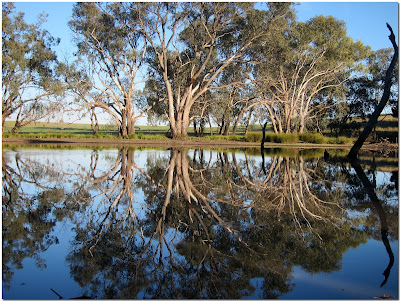The drive through Mount Kaputar National Park with its steep and winding roads gave the torque converter a real test. At some stages, we were down into third gear but the auto transmission temperature never climbed above 80 degrees so we are more than happy with those figures.
Bingara is one of our favourite spots to camp, and we have been coming here for the past ten years. Unfortunately, the introduction of Wiki Camps and Camps Australia has meant that more people have also found out about just how wonderful it is to camp along the banks of the Gwydir River. In the early days, we almost had the place to yourselves.
We have always camped east of the bridge with camps spreading for many kilometres but this is the first time we have camped north of the bridge and within the town area.
Camping is now permitted in three locations all bordering the river. We camped in the largest area just across the river from the golf course. It was the largest of the three and we were lucky to find a great spot surrounded by trees and shrubs that afforded us some privacy.
Bingara is renowned for receiving bad weather in particular storms with hail. One only has to look at the roofs on all the houses to realise that they are all new, even in the oldest of the homes.
On our second night, we thought we may be going to experience one of their storms with the sky off to the northeast being very dark but then it looked like we had missed it. In the early hours of the following morning, we were woken to the most amazing thunder and the lightning show followed by heavy rain. Our thoughts turned to several years ago when our van required a total reskin after a hail storm but thankfully this time we escaped although further north did experience hail.
After heading northeast on the road to Delungra we joined the Gwydir Highway as we headed towards Inverell and then onto Glen Innes, before heading down the range between Washpool and Gibraltar Range National Parks.
Our campsite tonight is at the bottom of the mountain at the Cangai Bridge. As you cross the grid you're confronted with a sign informing you that the road is unsuitable for caravans but this only applies to the road further on after crossing the two bridges and the camping area.
The area is quite large with views up the valley and the Mann River. Unfortunately yet again there were already eleven vans here when we arrived. It really didn't matter as we were just here for the evening before heading home. There are no facilities here except clean river water that could be used for filling your non-potable tanks. The nearest dump point is at the caravan park at Jackadgery where they charge $5 to empty your cassette.


























































